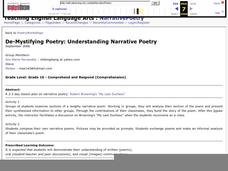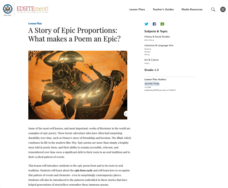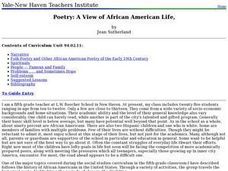Curated OER
De-Mystifying Poetry: Understanding Narrative Poetry
Tenth graders explore narrative poetry. They analyze sections of a poem and present to groups. They compose their own narrative poems using pictures as prompts. They exchange their poems and analyze their classmate's poem.
Curated OER
Maniac Magee: Found Poem
Instruct your readers to scrounge through the pages of Maniac Magee in search for descriptive passages or words they may use to write poetry. As they look for meaningful, sensory descriptors in Jerry Spinelli's novel, readers...
Curated OER
Plot the Oysters' Peril!
Use comic strips to teach sequencing in narrative poetry. As homework, each class member selects a comic strip with 4-8 frames, cuts the frames apart, places the pieces in an envelope, and brings the envelope to class. Class members swap...
Curated OER
A Handmade House Book with Student Writing
Use this lesson for your bookmaking project. First, young writers work on making an accordion fold house book. After composing a variety of pieces of writing, they can use their book to store their writing. The structure is ideal for a...
Prestwick House
Poe’s “The Raven” – Unity of Effect
How do Poe's choices of imagery, rhythm and rhyme scheme, and structure help build the desired single effect of "The Raven"? After listening to a dramatic reading of the poem, class members consider whether Poe's choices do...
University of Arizona
Fusing Firecrackers with Narrative
Improve your youngsters' descriptive writing. They study an object and write about what they see as a warm-up, then they read an excerpt from Paul Guest's memoir, One More Theory about Happiness. The next part of the...
Curated OER
Joyful Noise: Poems for Two Voices by Paul Fleischman
Do your young readers know that poems can be performed as a team? They listen to a few examples from Paul Fleischman's book Joyful Noise: Poems for Two Voices, paying attention to how the how readers work together....
Curated OER
Writing
Students write poems and a narrative story. In this writing lesson, students read stories and poems written by other students and read examples of haiku's and diamonte's. Students write an acrostic poem and a diamonte...
National Endowment for the Humanities
A Story of Epic Proportions: What Makes a Poem an Epic?
Learners analyze the epic poem form and its roots in oral tradition. In this epic poetry lesson, students research the epic hero cycle and recognize the pattern of events and elements. Learners analyze the patterns embedded in the stories.
Curated OER
Writing: Narrative, Expository, Persuasive, and Descriptive
If you are interested in having a basic framework for teaching expository, narrative, persuasive, and descriptive writing, this resource may help; however, you will have to find information on the different forms of writing to share with...
Curated OER
Say Hi to Haibun Fun
Students examine the Japanese writing form of Haibun. They identify the elements of Japanese prose and poetry, analyze a haibun for writing devices, complete a graphic organizer, and compose an original haibun as a form of journal keeping.
Curated OER
Developing a Central Idea in Narrative Writing
At the beginning of the lesson, the class discusses the central idea of a poem. After that, the teacher reads a poem, embedded in the plan, to the class. In groups of two or three, learners create their own poem in response to the...
Curated OER
Writing and Autobiography
Are you working on an autobiographical or narrative writing unit? Bring this lesson to your class, as it takes young writers through the process of drafting and sequencing an autobiography. After observing and demonstrating steps of the...
National Endowment for the Humanities
Robert Frost's "Mending Wall": A Marriage of Poetic Form and Content
High schoolers examine the relationship between a poem's form and its content in Robert Frost's poem, 'Mending Wall.' They read and analyze the poem, explore websites, listen to an audio clip of Frost reading the poem, and write an...
Curated OER
Making Poetry Writing Fun!
Students find a group of words from an unlikely source and turn them into a poem. They discuss the central image in two well-known poems by Langston Hughes and Emily Dickinson. They write their own short poem expressing one central...
Curated OER
Poetry: A View of African American Life,
Fifth graders analyze many examples of African-American poetry and examine how different poems reflect the cultural experiences of African-Americans. The poems and spirituals chosen are very effective for public presentation.
Curated OER
Place and Character in Poetry
Students examine how place in poetry helps give clues about character. In this poetry lesson, students read a poem while focusing on the descriptions of the room that is being described and predict what type of person would live there....
Curated OER
Ballad
Young balladeers analyze examples of ballads and generate a list of common traits (story, quatrains, rhyme schemes, refrains, etc.), then identify these traits in Robert W. Service's "The Cremation of Sam McGee" and a ballad written by...
Curated OER
Response to Literature: Anecdotal and Saga Memoir Poems
Students differentiate between anecdotal and saga memoir poems. In this response to literature instructional activity students analyze poems written by others then analyze incidents from their own lives to determine whether they meet the...
Curated OER
Creative Writing/Poetry Lesson Plan
Students complete poetry writing activities and art analysis activities. In this creative writing and art lesson, students analyze a cubist piece by Picasso and discuss abstraction. Students read a poem by Gertrude Stein about Picasso...
Novelinks
The Hobbit: Biopoem
As part of their reading of The Hobbit, readers create a biopoem for one of Tolkien's characters.
Curated OER
Pinhole Photo Narratives
Learners create original pieces of poetry and use this as a basis for a photography series using "pin-hole camera" techniques. This high school instructional activity is cross-curricular in scope.
Curated OER
Use of Personification and Imagery in Poetry
A reading of Theodore Roethke’s dark "Root Cellar" and Sylvia Plath’s more abstract "Mirror" launches a discussion of imagery and personification in poetry. After finding examples of personification in the poems, class members...
Curated OER
A Weigh we Go!
Here are some cross-curricular activities whil should help your kids understnad weight measurements and grammar. In this grammar and math lesson, learners read the book Skittles Riddles and practice counting and balancing skittles. They...

























